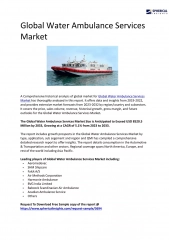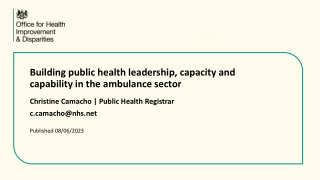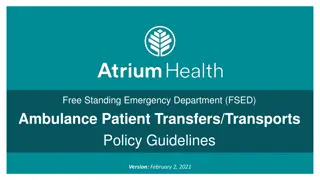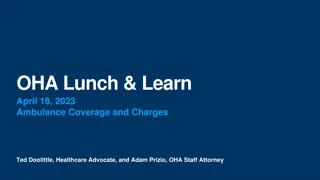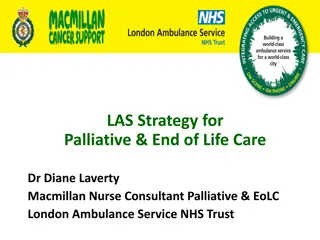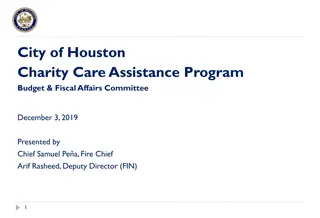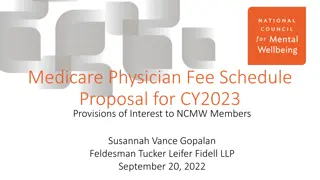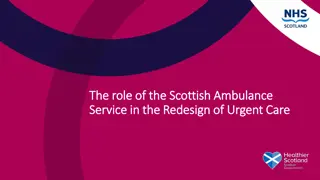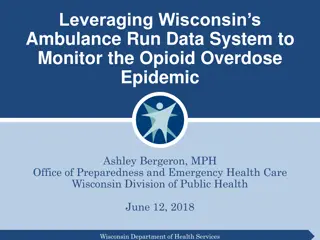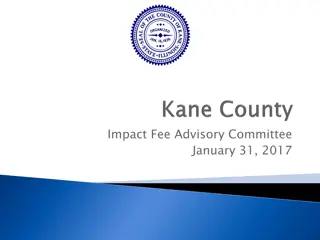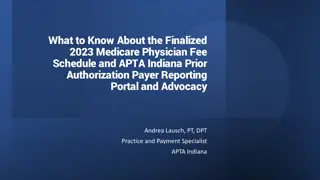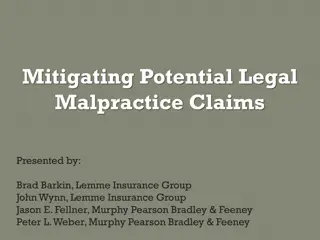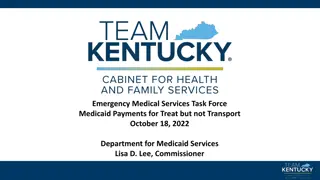EGID Ambulance Fee Schedule Implementation
Ambulance reimbursement methodology historical background, objectives analysis, findings considerations proposed changes. Impact on providers, timeline implementation discussed thoroughly. Evaluate reimbursement levels align with Oklahoma commercial market. Data on industry trends, Medicare rates, commercial payer ranges analyzed. Insights on recent trends, benchmarking against market medians highlighted.
Download Presentation

Please find below an Image/Link to download the presentation.
The content on the website is provided AS IS for your information and personal use only. It may not be sold, licensed, or shared on other websites without obtaining consent from the author.If you encounter any issues during the download, it is possible that the publisher has removed the file from their server.
You are allowed to download the files provided on this website for personal or commercial use, subject to the condition that they are used lawfully. All files are the property of their respective owners.
The content on the website is provided AS IS for your information and personal use only. It may not be sold, licensed, or shared on other websites without obtaining consent from the author.
E N D
Presentation Transcript
1 EGID Ambulance Fee Schedule Implementation PUBLIC HEARING OCT. 16, 2018 3872
Presentation Topics 2 Background/EGID s current ambulance reimbursement methodology. Objectives and analysis. Findings and considerations. Proposed changes to ambulance reimbursement. Rationale for EGID s adoption of a fee schedule for ambulance services. Impact on providers. Timeline for implementation.
Background/EGID Ambulance Reimbursement Methodology 3 Ambulance reimbursement has historically been based on a percentage of billed charges. Reimbursement rates and expenditures associated with ambulance claims were last reviewed in 2011 but no changes to the reimbursement methodology were made. EGID currently processes claims for ambulance services (both ground and air) on a by report (BR) basis. Providers are reimbursed a percentage of billed charges. A high percentage of billed charges is typically paid. In many cases, 100 percent of billed charges is paid.
Objectives and Analysis 4 Primary objective: Evaluate whether EGID reimbursement levels for ambulance services are in alignment with the Oklahoma commercial market. Analytical steps: Reviewed EGID s utilization, reimbursement levels and historical cost trends. Assessed current EGID reimbursement levels in the context of Oklahoma commercial payer ranges and Medicare payment levels. Conducted research on ambulance industry trends. Conducted research on Medicare and commercial payer ambulance reimbursement methodologies and trends.
Findings and Considerations 5 Ambulance charges have increased substantially in recent years, particularly for air ambulance services. For example, a recent study conducted by Berkeley Research Group (using Medicare data) found that from 2012 to 2015, the average charge for fixed wing transport (A0430) increased 51.2 percent and the average charge for rotary wing transport (A0431) increased 48.2 percent1. Due to increases in billed charges, EGID s average allowed per claim has also increased. For the same time period (2012-2015), EGID s average allowed per claim increased by 49 percent for fixed wing transport and 41 percent for rotary wing transport. Charges and allowed amounts continued to increase in 2016 and 2017 as well. EGID s ground ambulance reimbursement has also increased. Average allowed amounts increased by nearly 20 percent from 2012 to 2017. 1Eye on Healthcare: Air Ambulance Industry Trends and Legislative Update. July 24, 2017.
Findings and Considerations 6 Benchmarking analyses showed current EGID reimbursement levels are well above Oklahoma market medians for both ground and air ambulance services. The ambulance industry has expressed concerns regarding inadequacy of Medicare rates and the need to obtain higher reimbursement from commercial plans to offset negative Medicare margins.1 In its most recent ambulance report, the Medicare Payment Advisory Commission (MedPAC) found that, in aggregate, Medicare ambulance margins were adequate.2 Some commercial payers have moved away from reimbursement based on billed charges and have established fee schedules for ambulance services. 1First Research. Industry Report: Ambulance Services. April 18, 2016. 2Medicare Payment Advisory Commission. Mandated report: Medicare payment for ambulance services. June 2013.
Proposed Changes to EGID Ambulance Reimbursement 7 Establish a fee schedule using ambulance HCPCS billing codes. Fees are based on current Medicare rates with a multiple applied. Rural base rates and rural mileage rates will be used. No additional add-on payments will be applied. Proposed multiple for ground ambulance: 275 percent Proposed multiple for air ambulance: 475 percent Providers will no longer be reimbursed a percentage of billed charges.
Rationale for EGIDs Proposed Fee Schedule 8 Establishment of an ambulance fee schedule is a common commercial payer industry practice. Proposed fee schedule rates are within range of Oklahoma commercial market medians. A fee schedule allows for greater predictability of ambulance expense for EGID and more rational rates that do not vary based on billed charges. Fee schedule rates recognize the need for continued viability of rural ground ambulance providers.
Impact of Proposed Changes 9 Aggregate impact of the proposed changes is budget neutral to EGID. Air ambulance impact: -7 percent reduction from current allowed. Ground ambulance impact: 13 percent increase from current allowed. There is variation in impact across individual providers. Greater impacts will be realized for providers with high charges.
Proposed Timeline 10 Public hearing Oct. 16, 2018. Public hearing written comments due Oct. 24, 2018. Final proposed changes posted to the website by Oct. 31, 2018. Implementation Jan. 1, 2019.
11 Questions/Comments



